java图片验证码生成教程详解
发布于 2017-11-24 07:56:44 | 131 次阅读 | 评论: 0 | 来源: 网友投递
Java程序设计语言
java 是一种可以撰写跨平台应用软件的面向对象的程序设计语言,是由Sun Microsystems公司于1995年5月推出的Java程序设计语言和Java平台(即JavaEE(j2ee), JavaME(j2me), JavaSE(j2se))的总称。
这篇文章主要为大家详细介绍了java图片验证码生成教程,从简单到复杂,从本地到前后台,感兴趣的小伙伴们可以参考一下
首先,我们先来看本地如何生成图片验证码的,再来写输出到网页的验证码如何实现。
先来看最简单的—实现的功能是,将一个字符串变成图片写入到文件中
实现代码:
package cn.hncu.img;
import java.awt.Graphics;
import java.awt.image.BufferedImage;
import java.io.FileNotFoundException;
import java.io.FileOutputStream;
import java.io.IOException;
import javax.imageio.ImageIO;
//该类包含一些用来查找 ImageReader 和 ImageWriter 以及执行简单编码和解码的静态便捷方法。
import org.junit.Test;
public class ImgDemo {
//学习如何把一个字符串变成图片写到一个文件
@Test
public void ImgDemo1() throws FileNotFoundException, IOException{
BufferedImage img = new BufferedImage(60, 30, BufferedImage.TYPE_INT_RGB);
// 表示一个图像,它具有合成整数像素的 8 位 RGB 颜色分量。
Graphics g = img.getGraphics();
g.drawString("Hello",10,20);
//使用此图形上下文的当前字体和颜色绘制由指定 string 给定的文本。最左侧字符的基线位于此图形上下文坐标系的 (x, y) 位置处。
g.dispose();////类似于流中的close()带动flush()---把数据刷到img对象当中
//释放此图形的上下文以及它使用的所有系统资源。调用 dispose 之后,就不能再使用 Graphics 对象。
ImageIO.write(img, "JPG", new FileOutputStream("img/a.jpg"));
//使用支持给定格式的任意 ImageWriter 将一个图像写入 File。
}
}
结果:

上面那个很简单,对不对,我们看到的验证码都不是这样的,那好,我们给它加点干扰线,背景色,字符和y坐标随机生成。
有干扰线、背景色的验证码-写入文件
演示代码:
package cn.hncu.img;
import java.awt.Color;
import java.awt.Font;
import java.awt.Graphics;
import java.awt.image.BufferedImage;
import java.io.FileNotFoundException;
import java.io.FileOutputStream;
import java.io.IOException;
import java.util.Date;
import java.util.Random;
import javax.imageio.ImageIO;
//该类包含一些用来查找 ImageReader 和 ImageWriter 以及执行简单编码和解码的静态便捷方法。
import org.junit.Test;
public class ImgDemo {
//把上面的字符串改成我们平时用的验证码---生成几个随机数字,有背景色和干扰线
@Test
public void ImgDemo2() throws FileNotFoundException, IOException{
int width = 80;
int height= 40;
int lines = 10;
BufferedImage img = new BufferedImage(width, height, BufferedImage.TYPE_INT_RGB);
Graphics g = img.getGraphics();
//设置背景色
g.setColor(Color.white);
g.fillRect(0, 0, width, height);//画背景
//填充指定的矩形。使用图形上下文的当前颜色填充该矩形
//设置字体
g.setFont(new Font("宋体", Font.BOLD, 18));
//随机数字
Date d = new Date();
//System.out.println(d.getTime());
Random r = new Random(d.getTime());
for(int i=0;i<4;i++){
int a = r.nextInt(10);//取10以内的整数[0,9]
int y = 10+r.nextInt(20); //10~30范围内的一个整数,作为y坐标
Color c = new Color(r.nextInt(255), r.nextInt(255), r.nextInt(255));
g.setColor(c);
g.drawString(""+a, 5+i*width/4, y);
}
//干扰线
for(int i=0;i<lines;i++){
Color c = new Color(r.nextInt(255), r.nextInt(255), r.nextInt(255));
g.setColor(c);
g.drawLine(r.nextInt(width), r.nextInt(height), r.nextInt(width), r.nextInt(height));
}
g.dispose();//类似于流中的close()带动flush()---把数据刷到img对象当中
ImageIO.write(img, "JPG", new FileOutputStream("img/b.jpg"));
}
}
演示结果:

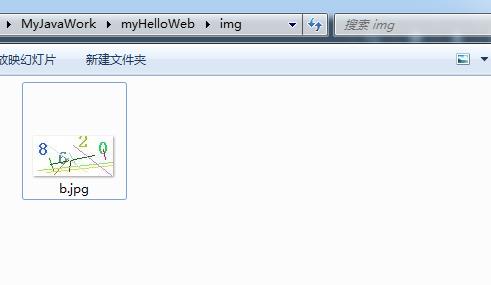
最后来看一个可以旋转和放缩的验证码-写到图片本地文件中
演示代码:
package cn.hncu.img;
import java.awt.Color;
import java.awt.Font;
import java.awt.Graphics;
import java.awt.Graphics2D;
import java.awt.geom.AffineTransform;
import java.awt.image.BufferedImage;
import java.io.FileNotFoundException;
import java.io.FileOutputStream;
import java.io.IOException;
import java.util.Date;
import java.util.Random;
import javax.imageio.ImageIO;
//该类包含一些用来查找 ImageReader 和 ImageWriter 以及执行简单编码和解码的静态便捷方法。
import org.junit.Test;
public class ImgDemo {
@Test//可以旋转和放缩的验证码
public void ImgDemo3() throws FileNotFoundException, IOException{
int width = 80;
int height = 40;
int lines = 10;
BufferedImage img = new BufferedImage(width, height, BufferedImage.TYPE_INT_RGB);
Graphics2D g2d = (Graphics2D)img.getGraphics();
g2d.setFont(new Font("宋体", Font.BOLD, 20));
Random r = new Random(new Date().getTime());
//设置背景色
g2d.setColor(new Color(r.nextInt(255), r.nextInt(255), r.nextInt(255)));
g2d.drawRect(0, 0, width, height);//绘制指定矩形的边框。
g2d.setColor(new Color(r.nextInt(255), r.nextInt(255), r.nextInt(255)));
g2d.fillRect(0, 0, width, height);//填充指定的矩形。
for(int i=0;i<4;i++){
String str = ""+r.nextInt(10);
//处理旋转
AffineTransform Tx = new AffineTransform();
Tx.rotate(Math.random(), 5+i*15, height-5);
//用弧度测量的旋转角度,旋转锚点的 X 坐标,旋转锚点的 Y 坐标
//Tx.scale(0.7+Math.random(), 0.7+Math.random());
//x坐标方向的缩放倍数,y坐标方向的缩放倍数
g2d.setTransform(Tx);
Color c = new Color(r.nextInt(255), r.nextInt(255), r.nextInt(255));
g2d.setColor(c);
g2d.drawString(str, 2+i*width/4, height-13);
}
//干扰线
for(int i=0;i<lines;i++){
Color c = new Color(r.nextInt(255), r.nextInt(255), r.nextInt(255));
g2d.setColor(c);
g2d.drawLine(r.nextInt(width), r.nextInt(height), r.nextInt(width), r.nextInt(height));
}
g2d.dispose();
ImageIO.write(img, "JPG", new FileOutputStream("img/c.jpg"));
}
}
演示结果:

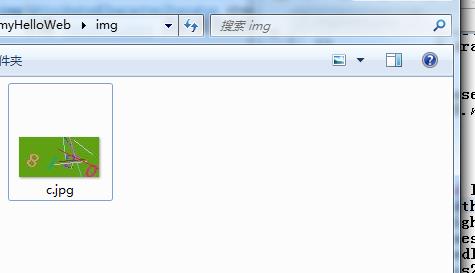
下面就要开始演示前台的图片验证技术了。
前台的图片验证技术
这个项目的结构图:
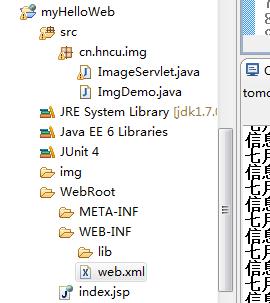
index.jsp:
<%@ page language="java" import="java.util.*" pageEncoding="utf-8"%>
<!DOCTYPE HTML PUBLIC "-//W3C//DTD HTML 4.01 Transitional//EN">
<html>
<head>
<script type="text/javascript">
function changImg(){
var img = document.getElementById("servletImg");
var d = new Date();
var time = d.getTime();//如果没有这个
//下面这一句不会起作用,因为浏览器的缓存技术,图片并不会刷新
//img.src="/myHelloWeb/servlet/ImageServlet";
img.src="/myHelloWeb/servlet/ImageServlet?"+time;
//?号后面的东西是通过get方式传递的
}
</script>
</head>
<body>
这是我的手动主页!
<br/>
<img id="servletImg" src="/myHelloWeb/servlet/ImageServlet" /><a href="javascript:changImg()">看不清</a>
</body>
</html>
web.xml:
<?xml version="1.0" encoding="UTF-8"?>
<web-app version="3.0"
xmlns="http://java.sun.com/xml/ns/javaee"
xmlns:xsi="http://www.w3.org/2001/XMLSchema-instance"
xsi:schemaLocation="http://java.sun.com/xml/ns/javaee
http://java.sun.com/xml/ns/javaee/web-app_3_0.xsd">
<display-name></display-name>
<servlet>
<description>This is the description of my J2EE component</description>
<display-name>This is the display name of my J2EE component</display-name>
<servlet-name>ImageServlet</servlet-name>
<servlet-class>cn.hncu.img.ImageServlet</servlet-class>
</servlet>
<servlet-mapping>
<servlet-name>ImageServlet</servlet-name>
<url-pattern>/servlet/ImageServlet</url-pattern>
</servlet-mapping>
<welcome-file-list>
<welcome-file>index.jsp</welcome-file>
</welcome-file-list>
</web-app>
ImageServlet.java
package cn.hncu.img;
import java.awt.Color;
import java.awt.Font;
import java.awt.Graphics;
import java.awt.image.BufferedImage;
import java.io.IOException;
import java.io.PrintWriter;
import java.util.Date;
import java.util.Random;
import javax.imageio.ImageIO;
import javax.servlet.ServletException;
import javax.servlet.http.HttpServlet;
import javax.servlet.http.HttpServletRequest;
import javax.servlet.http.HttpServletResponse;
public class ImageServlet extends HttpServlet {
public void doGet(HttpServletRequest request, HttpServletResponse response)
throws ServletException, IOException {
doPost(request, response);
}
public void doPost(HttpServletRequest request, HttpServletResponse response)
throws ServletException, IOException {
//告诉客户端,输出的格式
response.setContentType("image/jpeg");
int width = 80;
int height = 40;
int lines = 10;
BufferedImage img = new BufferedImage(width, height, BufferedImage.TYPE_INT_RGB);
Graphics g = img.getGraphics();
//设置背景色
g.setColor(Color.WHITE);
g.fillRect(0, 0, width, height);
//设置字体
g.setFont(new Font("宋体", Font.BOLD, 20));
//随机数字
Random r = new Random(new Date().getTime());
for(int i=0;i<4;i++){
int a = r.nextInt(10);
int y = 10+r.nextInt(20);//10~30范围内的一个整数,作为y坐标
Color c = new Color(r.nextInt(255),r.nextInt(255),r.nextInt(255));
g.setColor(c);
g.drawString(""+a, 5+i*width/4, y);
}
//干扰线
for(int i=0;i<lines;i++){
Color c = new Color(r.nextInt(255),r.nextInt(255),r.nextInt(255));
g.setColor(c);
g.drawLine(r.nextInt(width), r.nextInt(height), r.nextInt(width), r.nextInt(height));
}
g.dispose();//类似于流中的close()带动flush()---把数据刷到img对象当中
ImageIO.write(img, "JPG", response.getOutputStream());
}
}
演示结果:
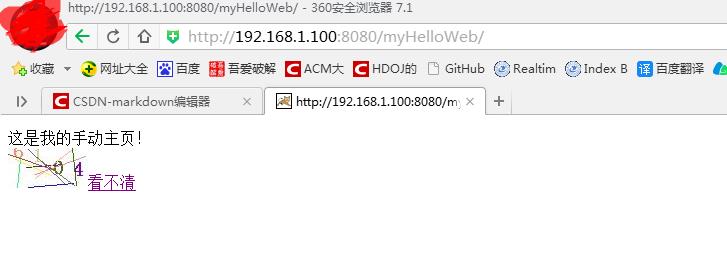
下面这个是在index.jsp中:
如果是用这句:
img.src=”/myHelloWeb/servlet/ImageServlet”;
大家可以看看响应头:

再看看用这句的响应头:
img.src=”/myHelloWeb/servlet/ImageServlet?”+time;
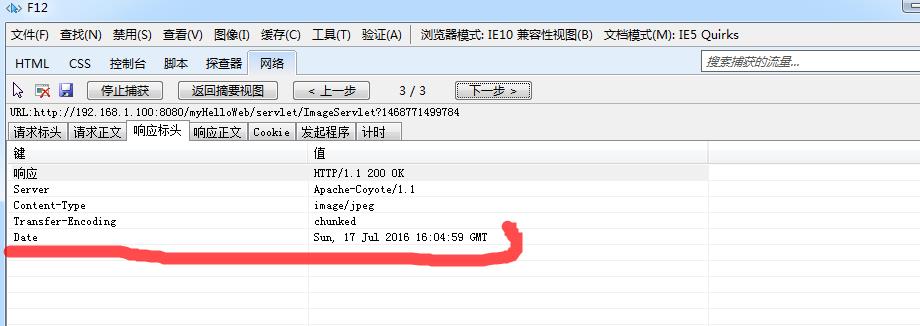
多了个Date响应!
因为时间一直在变,所以每次点看不清,都会再向服务器请求一次,而不会因为浏览器的缓存,而不去请求了。
验证码就先到这里结束啦。
以上就是本文的全部内容,希望对大家的学习有所帮助,也希望大家多多支持PHPERZ。
推荐阅读
最新资讯